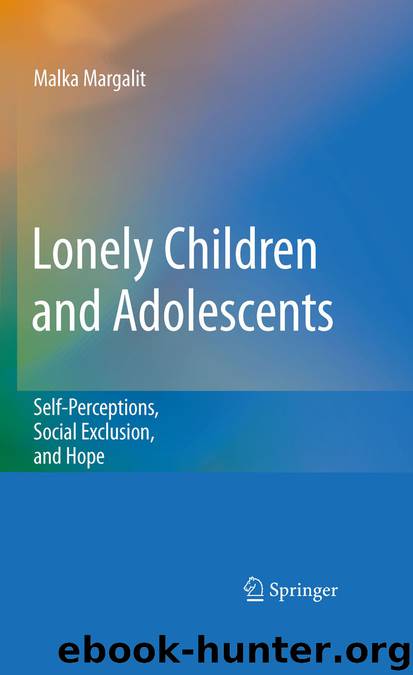Lonely Children and Adolescents by Malka Margalit

Author:Malka Margalit
Language: eng
Format: epub
Publisher: Springer New York, New York, NY
Clique Affiliation
Beginning in middle childhood, children tend to form exclusive peer affiliations called “cliques” (Kwon & Lease, 2009). Children in a clique are likely to share similar social information and experiences, and often keep frequent, intense, and exclusive interactions (Gest, Farmer, Cairns, & Xie, 2003). Clique members are often similar in many social and behavioral characteristics, including grades, academic motivation, school adjustment, aggression, externalizing and internalizing problems (Kiuru, Nurmi, Aunola, & Salmela-Aro, 2009). They are also perceived by peers as highly similar, even when the basis of that similarity is not explicitly specified. Children’s involvement in a clique contributes differently to their social and emotional adjustment and loneliness depending on the type of clique to which they belong (Kwon & Lease, 2007). When competent cliques are perceived to be highly cohesive, they may affect clique members favorably as each member becomes more strongly associated with the positive reputation (i.e., prosocial, smart, fun) of their clique, and they experience lower levels of loneliness (Kwon & Lease, 2009). This is usually considered a protective factor (Rubin et al., 2009). Nevertheless, when friends shared similarities in cliques’ maladaptive characteristics, such as bullying and aggression, friendship appeared to be a risk rather than a protective factor for adjustment. If the child’s mutual friends were socially withdrawn, he or she was more likely to show an increase in social withdrawal (Oh et al., 2008). Similarly, children belonging to groups with a norm for bullying were also found to display more bullying behaviors than those who belonged to groups with an anti-bullying norm (Duffy & Nesdale, 2009).!!!
In conclusion, friendships in childhood and adolescence provide many important provisions such as affection, good company, and fun; the emotional security and helpfulness among friends meet their varied needs for advice as well as for instrumental aid. Friendship relations enable sharing of interests, hopes, and fears and provide opportunities for intimate disclosure. Friends are thought to bolster feelings of self-worth and promote the growth of social skills and inter-personal sensitivity (Rubin et al., 2008). Mutual enemies are considered a risk for children’s pronounced loneliness and distress. However, friendship with aggressive children may be considered a risk factor for development, while friends who are not aggressive can provide an adaptive socializing influence and promote the resilience even for victimized children. The drive to initiate and sustain friendship bonds is so fundamental to the human experience, that even adolescents, who develop friendship bonds with deviant, delinquent, or abusive peers belonging to aggressive cliques, report lower levels of loneliness than their friendless adolescent peers (Asher & Paquette, 2003). Needless to say that friendship with a well-behaved classmate can enhance the development of skills that facilitate behavioral and cognitive engagement in the classroom. Likewise, non-aggressive friends may encourage positive attitudes toward school by providing social support and companionship for victimized children (Schwartz et al., 2008). Thus, satisfactory friendship relations predicted lower levels of loneliness and was also related indirectly to popularity. Popularity among children strongly influenced friendship, which, in turn, affected loneliness. It appears
Download
This site does not store any files on its server. We only index and link to content provided by other sites. Please contact the content providers to delete copyright contents if any and email us, we'll remove relevant links or contents immediately.
The Art of Coaching Workbook by Elena Aguilar(50987)
Trainspotting by Irvine Welsh(21518)
Twilight of the Idols With the Antichrist and Ecce Homo by Friedrich Nietzsche(18503)
Fangirl by Rainbow Rowell(9095)
Periodization Training for Sports by Tudor Bompa(8170)
Change Your Questions, Change Your Life by Marilee Adams(7635)
This Is How You Lose Her by Junot Diaz(6794)
Asking the Right Questions: A Guide to Critical Thinking by M. Neil Browne & Stuart M. Keeley(5633)
Grit by Angela Duckworth(5523)
Red Sparrow by Jason Matthews(5390)
Paper Towns by Green John(5089)
Room 212 by Kate Stewart(5037)
Ken Follett - World without end by Ken Follett(4645)
Housekeeping by Marilynne Robinson(4347)
The Sports Rules Book by Human Kinetics(4294)
Double Down (Diary of a Wimpy Kid Book 11) by Jeff Kinney(4207)
Papillon (English) by Henri Charrière(4195)
The Motorcycle Diaries by Ernesto Che Guevara(4012)
Exercise Technique Manual for Resistance Training by National Strength & Conditioning Association(3955)
